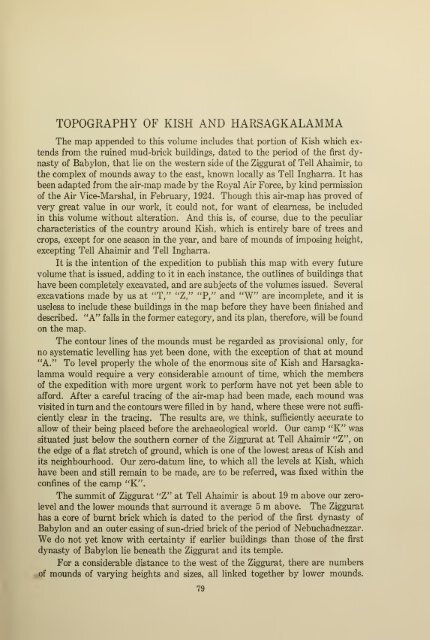A Sumerian Palace and the "A" cemetery at Kish, Mesopotamia
A Sumerian Palace and the "A" cemetery at Kish, Mesopotamia
A Sumerian Palace and the "A" cemetery at Kish, Mesopotamia
Create successful ePaper yourself
Turn your PDF publications into a flip-book with our unique Google optimized e-Paper software.
TOPOGRAPHY OF KISH AND HARSAGKALAMMA<br />
The map appended to this volume includes th<strong>at</strong> portion of <strong>Kish</strong> which ex-<br />
tends from <strong>the</strong> ruined mud-brick buildings, d<strong>at</strong>ed to <strong>the</strong> period of <strong>the</strong> first dy-<br />
nasty of Babylon, th<strong>at</strong> lie on <strong>the</strong> western side of <strong>the</strong> Ziggur<strong>at</strong> of Tell Ahaimir, to<br />
<strong>the</strong> complex of mounds away to <strong>the</strong> east, known locally as Tell Ingharra. It has<br />
been adapted from <strong>the</strong> air-map made by <strong>the</strong> Royal Air Force, by kind permission<br />
of <strong>the</strong> Air Vice-Marshal, in February, 1924. Though this air-map has proved of<br />
very gre<strong>at</strong> value in our work, it could not, for want of clearness, be included<br />
in this volume without alter<strong>at</strong>ion. And this is, of course, due to <strong>the</strong> peculiar<br />
characteristics of <strong>the</strong> country around <strong>Kish</strong>, which is entirely bare of trees <strong>and</strong><br />
crops, except for one season in <strong>the</strong> year, <strong>and</strong> bare of mounds of imposing height,<br />
excepting Tell Ahaimir <strong>and</strong> Tell Ingharra.<br />
It is <strong>the</strong> intention of <strong>the</strong> expedition to publish this map with every future<br />
volume th<strong>at</strong> is issued, adding to it in each instance, <strong>the</strong> outlines of buildings th<strong>at</strong><br />
have been completely excav<strong>at</strong>ed, <strong>and</strong> are subjects of <strong>the</strong> volumes issued. Several<br />
excav<strong>at</strong>ions made by us <strong>at</strong> "T," "Z," "P," <strong>and</strong> "W" are incomplete, <strong>and</strong> it is<br />
useless to include <strong>the</strong>se buildings in <strong>the</strong> map before <strong>the</strong>y have been finished <strong>and</strong><br />
described. "A" falls in <strong>the</strong> former c<strong>at</strong>egory, <strong>and</strong> its plan, <strong>the</strong>refore, will be found<br />
on <strong>the</strong> map.<br />
The contour lines of <strong>the</strong> mounds must be regarded as provisional only, for<br />
no system<strong>at</strong>ic levelling has yet been done, with <strong>the</strong> exception of th<strong>at</strong> <strong>at</strong> mound<br />
"A." To level properly <strong>the</strong> whole of <strong>the</strong> enormous site of <strong>Kish</strong> <strong>and</strong> Harsagkalamma<br />
would require a very considerable amount of time, which <strong>the</strong> members<br />
of <strong>the</strong> expedition with more urgent work to perform have not yet been able to<br />
afford. After a careful tracing of <strong>the</strong> air-map had been made, each mound was<br />
visited in turn <strong>and</strong> <strong>the</strong> contours were filled in by h<strong>and</strong>, where <strong>the</strong>se were not suffi-<br />
ciently clear in <strong>the</strong> tracing. The results are, we think, sufficiently accur<strong>at</strong>e to<br />
allow of <strong>the</strong>ir being placed before <strong>the</strong> archaeological world. Our camp "K" was<br />
situ<strong>at</strong>ed just below <strong>the</strong> sou<strong>the</strong>rn corner of <strong>the</strong> Ziggur<strong>at</strong> <strong>at</strong> Tell Ahaimir "Z", on<br />
<strong>the</strong> edge of a fi<strong>at</strong> stretch of ground, which is one of <strong>the</strong> lowest areas of <strong>Kish</strong> <strong>and</strong><br />
its neighbourhood. Our zero-d<strong>at</strong>um line, to which all <strong>the</strong> levels <strong>at</strong> <strong>Kish</strong>, which<br />
have been <strong>and</strong> still remain to be made, are to be referred, was fixed within <strong>the</strong><br />
confines of <strong>the</strong> camp "K".<br />
The summit of Ziggur<strong>at</strong> "Z" <strong>at</strong> Tell Ahaimir is about 19 m above our zero-<br />
level <strong>and</strong> <strong>the</strong> lower mounds th<strong>at</strong> surround it average 5 m above. The Ziggur<strong>at</strong><br />
has a core of burnt brick which is d<strong>at</strong>ed to <strong>the</strong> period of <strong>the</strong> first dynasty of<br />
Babylon <strong>and</strong> an outer casing of sun-dried brick of <strong>the</strong> period of Nebuchadnezzar.<br />
We do not yet know with certainty if earlier buildings than those of <strong>the</strong> first<br />
dynasty of Babylon lie bene<strong>at</strong>h <strong>the</strong> Ziggur<strong>at</strong> <strong>and</strong> its temple.<br />
For a considerable distance to <strong>the</strong> west of <strong>the</strong> Ziggur<strong>at</strong>, <strong>the</strong>re are numbers<br />
,,.of mounds of varying heights <strong>and</strong> sizes, all linked toge<strong>the</strong>r by lower mounds.<br />
79

















